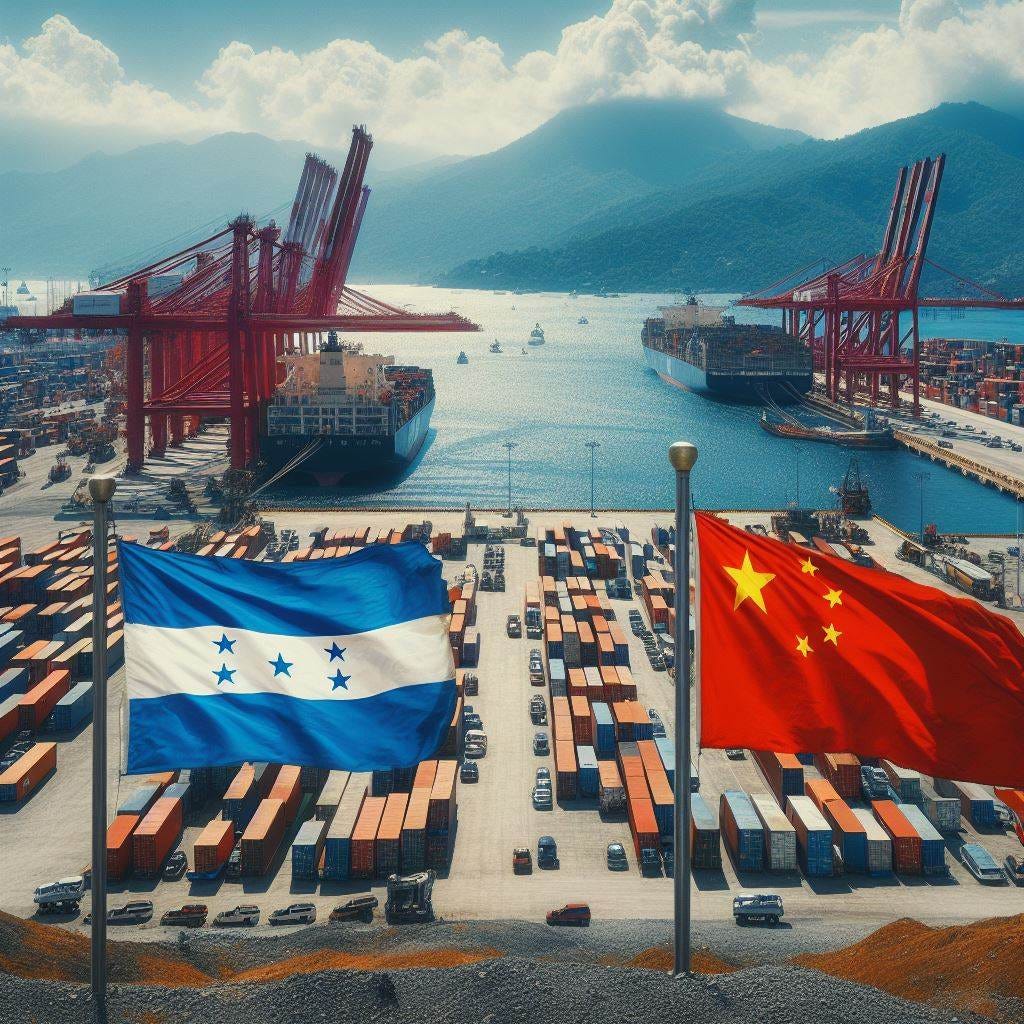One Year After Honduras' Pivot To China Garners Trade, Infrastructure and Technology
Just one year after Honduras' diplomatic shift towards China the impact on trade, infrastructure, and technology has been significant and there's more to come.
The geopolitical implications of Honduras' 2023 pivot towards China are significant as It reflects China's growing presence in Latin America and the strategic competition for influence in the region. The decision by Honduras to embrace Beijing has sparked debates about the future of Taiwan's ever-shrinking diplomatic network and the broader dynamics of power and alliance in international politics. The article will serve as a 1-year update on Honduran-Chinese relations, how they are going thus far, and where are they headed.
The diplomatic relationship between China and Honduras, which officially commenced in March 2023 as was covered in a previous article “Honduras Disregards United States' Ultimatum By Establishing Ties With China”, marked a significant shift in international relations within both the central American geopolitics and the One-China policy. This was followed by face-to-face meetings between President Xi and Honduran president, Xiomara Castro in Beijing in June 2023. Right then President Xi Jinping announced China's willingness to begin talks on a free trade agreement with Honduras "as soon as possible" further cementing the economic dimension of this partnership. The two sides started the FTA negotiations in July 2023, about four months after the establishment of diplomatic relations.
Trade & Commerce
After the establishment of diplomatic relations between China and Honduras, import and export trade procedures have been greatly simplified. As a preliminary state of business on June 13, 2023, the General Administration of Customs of China issued Notice No. 67, which allows the direct import into China of raw coffee beans produced throughout Honduras that meet the relevant requirements.
Not long after that, the two sides started the proper FTA negotiations in July 2023, and they crafted agreements that would allow more Honduran agricultural products to be exported to China and generate numerous jobs through investments from Chinese businessmen under the framework of the FTA. Both parties understand the growth potential of China-Honduras trade as was confirmed at the sixth China International Import Expo (CIIE) held in Shanghai in November 2023. Honduras attended the CIIE for the first time and as the Guest Country of Honor exhibited signature Honduran products, especially agricultural and marine products, which were very well received by visitors. Honduras believes they are going to be able to develop an extraordinary trade relationship in the areas of tobacco, coffee, shrimp, and sugar, among other products.
Infrastructure
Infrastructure development is another pillar of the China-Honduras relationship. China has expressed firm support for Honduras in choosing its development path, aligning with national conditions. The shift from Taipei to Beijing was influenced by economic considerations, by bilateral trade but also with the construction of imperative game-changing infrastructure like a hydroelectric dam, Patuca II by POWERCHINA SINOHYDRO, in Honduras which was successfully connected to the national grid on Dec 20, 2023. It is the country's biggest hydroelectric power plant in 30 years and is the largest infrastructure construction project being implemented in the country.
This support extends to infrastructure investments particularly in the realm of port modernization, as it is of vital importance for functional commerce of every state, indicative of China's growing infrastructure networking in Latin America. The modernization of Honduran ports with Chinese smart technology not only reflects the deepening of bilateral relations but also underscores the geopolitical shifts in the region as countries seek to diversify their economic partnerships.
Additionally, China has shown interest in investing in the construction of a transoceanic train rail that will connect the Atlantic and Pacific coasts of Honduras. The proposed $20 billion train rail project, with an estimated 15-year construction timeline, is part of a broader initiative of trade and investment between both countries. As Honduras's dip diplomatic ties to China grow The Hope here is that the mega infrastructure project linking this Pacific Coast Port of San Lorenzo to the Caribbean coast Port of Puerto Cortes on the Atlantic May soon become a reality, transforming global trade routes in the process.
The project linking the coasts would allow Maritime cargo to move from the Pacific to the Atlantic ports in four to five hours and could also include infrastructure in neighboring El Salvador which already has close relations with China. Currently, the fastest way for cargo to cross the continent is through the Panama Canal but the government here says this project could be a better and more practical solution. Today given the saturation at the Panama Canal boats sometimes have to wait as long as 10 days offshore before being allowed through so this project could be a great provider for the region. The railway would have an enormous economic impact by connecting this country's two most important ports and thus connecting the Asian markets directly with the European markets, which would be an enormous competitive edge for Honduras in global trade.
These moves align with China's broader strategy to expand its economic horizons through infrastructure investment and trade agreements with the global south. In conclusion, the China-Honduras relationship is a testament to the evolving landscape of global geopolitics, where economic interests and strategic partnerships are reshaping traditional alliances. As both nations embark on this new chapter, the focus on trade, infrastructure, and mutual development promises to bring about transformative changes, with implications that extend far beyond their bilateral ties. The unfolding of this relationship will be closely watched by the international community, as it may signal further shifts in the balance of power and influence in Latin America and beyond.



